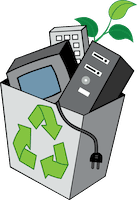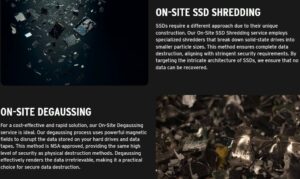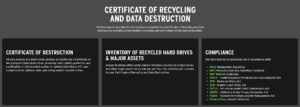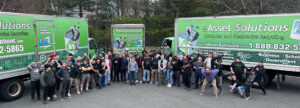When considering onsite data destruction there are some key practices to follow and some pitfalls to avoid like the plague. Things like choosing the right method and the right provider can mean the difference between absolute security and landing yourself in a lawsuit. Unfortunately, while data breaches aren’t new, they still manage to surprise you at some levels more than others, as when Morgan Stanley recently suffered a breach after hiring a moving company with zero data destruction experience.
And that misstep cost them, not just financially, but in the currency of public trust.
So today we’re going to take a look at the 7 Best Practices for Onsite Data Destruction to help guide you through the right steps for doing it safely, by the book, and if you’re in the DMV, with us.
Aprés vouz!
7 Best Practices for Onsite Data Destruction
1. Partner with a Certified Data Destruction Provider
First thing’s first: partner with a provider with industry-recognized certifications like R2v3, e-Stewards or NAID AAA. These certifications are more than paperwork with watermarks. They’re proof-positive that your vendor meets the toughest standards for secure, ethical, and responsible onsite data destruction. If they don’t have these, keep it moving.
Because remember: certified providers are certified for a reason. They are regularly audited, held to rigorous procedural standards, and trained to handle every type of device in compliance with data security laws. Just as importantly, they provide reliable paperwork that protects you during compliance checks or legal scrutiny.
2. One Size Doesn’t Fit All in Data Destruction
Not every device can be destroyed the same way. For example: while degaussing works very well for older hard drives and data tapes, SSDs need shredding to be completely secure. Because SSDs store data in non-magnetic flash memory chips, making them unaffected by degaussing. Using the wrong method for data destruction could potentially leave some data still recoverable, and that’s a risk no one can afford to take.
So matching the right data destruction method to the job keeps your sanitization process efficient and compliant. And if you’re unsure, ask!
3. Be There When It Happens

BE THERE WHEN IT HAPPENS
If your business manages highly sensitive information, you shouldn’t just hand over devices and hope for the best. You have agency. Insist on being there when it happens. Have a designated employee or external auditor present during the onsite data destruction process. Watching it happen in real time guarantees that nothing slips through the cracks.
Some companies even go a step further by offering live-streamed or recorded video footage. So if you can’t be there in person you still still make sure the job is done right and have the video to back it up.
4. Insist on Chain-of-Custody Records

INSIST ON PROPER DOCUMENTATION
Insisting on a thorough chain of custody at every phase of data destruction is another critical element, not to be overlooked. Your data destruction provider should give you a full breakdown of what was destroyed, when, how, and by whom. Some details to look for include, but are not limited to:
- Serial numbers of all devices
- Exact date/time of destruction
- Technician name or IDs
- Method of Destruction Used
These records aren’t just helpful, they’re essential. They serve as evidence of compliance during audits and help your business meet regulatory standards with confidence. Proper documentation delivers transparency, accountability, and long-term peace of mind.
5. Make Routine Onsite Data Destruction Part of Your Workflow

MAKE ONSITE DATA DESTRUCTION ROUTINE
By making routine data destruction part of your regular workflow you avoid stockpiling outdated hard drives, data tapes and mobile devices. So set a recurring schedule to destroy obsolete equipment before it becomes a threat. Monthly? Quarterly? Bi-yearly? It doesn’t matter. The point is that regular cleanouts not only reduce data liability but also improve operational efficiency.
It also saves time during compliance reviews and IT audits. But most importantly, it demonstrates your ongoing commitment to data security, not just one-off, one-time cleanups.
6. Think Eco-friendly and Recycle Responsibly
Now once your drives are shredded or degaussed, what happens to the leftover pieces? Work only with providers who follow strict e-waste regulations and hold recognized certifications like R2v3 and e-Stewards. These standards guarantee that e-waste is handled legally, safely, and sustainably.
Responsible recycling lowers your business’s environmental footprint and contributes to long-term sustainability goals. It also helps support the circular economy by returning usable resources into the manufacturing stream. It’s not only a green initiative but a smart way of doing business that reinforces your ESG commitments.
7. Certificate of Data Destruction is a Must
And finally, no data destruction job is complete without a Certificate of Data Destruction. This document certifies that sensitive information was permanently destroyed using approved data destruction methods.
Think of the CoD as your receipt for peace of mind. It’s an essential part of your compliance toolkit, especially if you’re audited or subject to data security regulations. Keeping these documents organized helps your business respond quickly in the event of a legal or security inquiry.
Final Thoughts
Onsite data destruction keeps you in control from start to finish. It removes the guesswork, cuts down on risk, and supports both your compliance and environmental goals. With secure methods like onsite shredding and degaussing, plus reliable documentation, you’re setting your business up for success and safety.
At eAsset Solutions we make it easy to do the right thing with onsite data destruction services designed around your needs. From flexible scheduling to multi-location coverage, we come to you: ready to deliver peace of mind.
Reach out today to keep your data secure and your operations on all levels worry-free.









